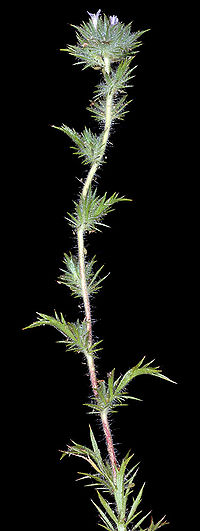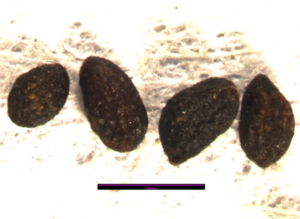Navarretia squarrosa
- Latin Name: Navarretia squarrosa
- Family: Polemoniaceae
- Common Names: skunkweed
- Synonyms/Misapplications: Gilia squarrosa
- Codon: NAVSQU
Contents
Taxonomy
| Navarretia squarrosa' | |
|---|---|
| Scientific classification | |
| Kingdom: | Plantae |
| Subkingdom: | Tracheobionta |
| Phylum: | Spermatophyta |
| Subphylum: | Magnoliophyta |
| Class: | Magnoliopsida |
| Subclass: | Asteranae |
| Order: | Ericales |
| Family: | Polemoniaceae |
| Genus: | Navarretia Ruiz & Pav. |
| Species: | Navarretia squarrosa (Eschsch.) Hook. & Arn. |
Description
General: Erect, simple or moderately branched, glandular-hairy annual up to 4 dm. tall, smelling of skunk.
Leaves: Leaves firm and spiny, pinnatifid or bipinnatifid, up to 6 cm. long, the terminal segment not elongate.
Flowers: Inflorescence of dense, leafy-bracteate heads terminating the stem and branches, the heads often 3 cm. thick, the bracts pinnatifid; calyx 8-14 mm. long, the 5 lobes nearly equal, mostly entire; corolla pale to deep blue, about equal to the calyx, the 5 lobes 2-3 mm. long, three veined; filaments 1-4 mm. long, inserted at least 2.5 mm. below the sinuses of the corolla; stigmas 3; ovary 3-celled, superior.
Fruit: Inflorescence of dense, leafy-bracteate heads terminating the stem and branches, the heads often 3 cm. thick, the bracts pinnatifid; calyx 8-14 mm. long, the 5 lobes nearly equal, mostly entire; corolla pale to deep blue, about equal to the calyx, the 5 lobes 2-3 mm. long, three veined; filaments 1-4 mm. long, inserted at least 2.5 mm. below the sinuses of the corolla; stigmas 3; ovary 3-celled, superior
Bloom Period
June - September[1]
Distribution
West of the Cascades, from southern Vancouver Island, British Columbia, to California.[1]
Habitat
Open places, dry to moist meadows, usually at low elevations. Grows in sandy, loamy, or clay soils, and tolerates basic, neutral, or acidic soils. Soil moisture level can be dry to moist, but must drain well. Navarretia squarrosa is shade tolerant, prefers sun.
Uses
Navarretia squarrosa has an edible seed when it is parched, ground into a powder and eaten dry. [94].
Propagation
Seed
Seed sample from: 2011
Average Measurement: 0.9 x 0.6 x 0.5
Measurement Range: L: 0.75 – 1.1, W: 0.5 – 0.75, D: 0.4 – 0.5
Features
Shape: Seeds tapered to almost pointed at hilum ends. Body of seeds sometimes not completely filled out – some concave dents. Hilum is pinched looking in some.
Color: Seeds reddish brown, hilum usually slightly lighter in color, but not very conspicuous.
Surface: Seeds covered in wrinkly pitted pattern. About 30 – 40 medium sized pits visible on one seed face. Seeds slightly rough looking, and somewhat lustrous.
Latitudinal Cross Section: elliptical 
Longitudinal Cross Section: elliptical ![]()
Basic Explanations and Assumptions:
The dimensions for the seeds are length x width x depth. The location of the hilum is used as the base of the seed, and the length is measured from hilum to the opposite apex. Where a style is present, the length is measured from the hilum to the bottom of the style. Width is measured at a right angle to the length at the widest part. Depth is measured at a right angle to the intersection of height and width lines.
Measurements included are the mean average for each measurement of ten separate seeds.
All measurements in millimeters unless otherwise noted.




